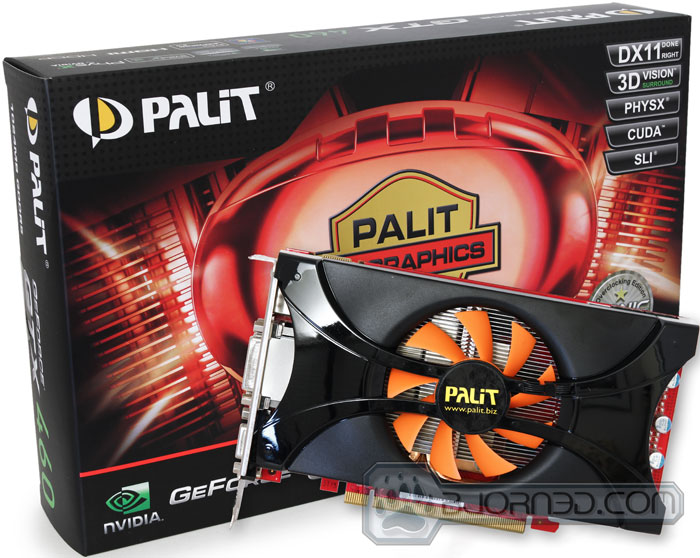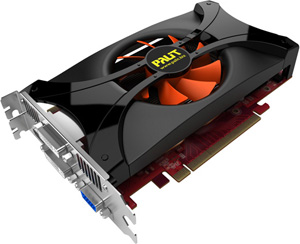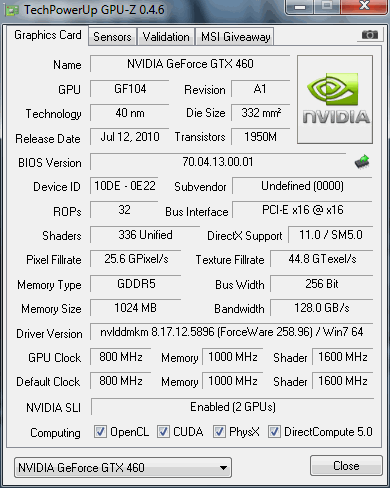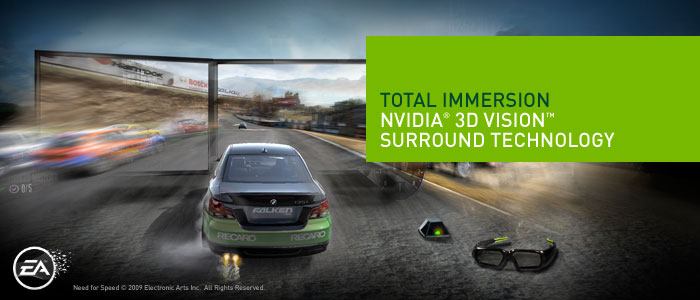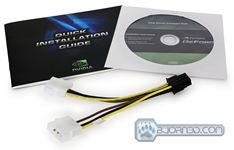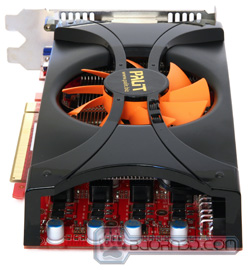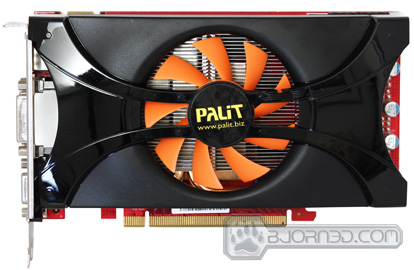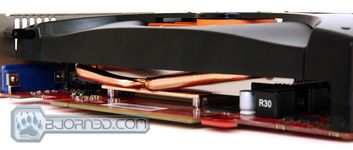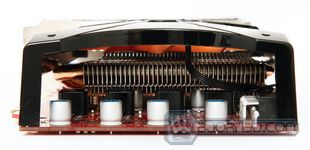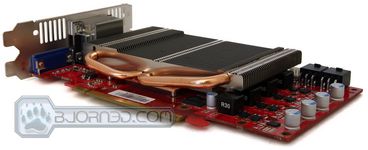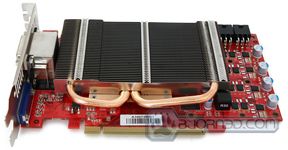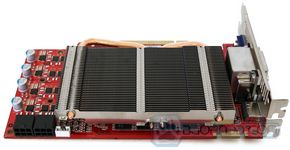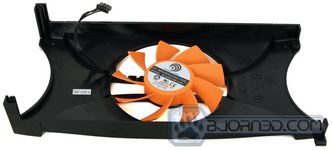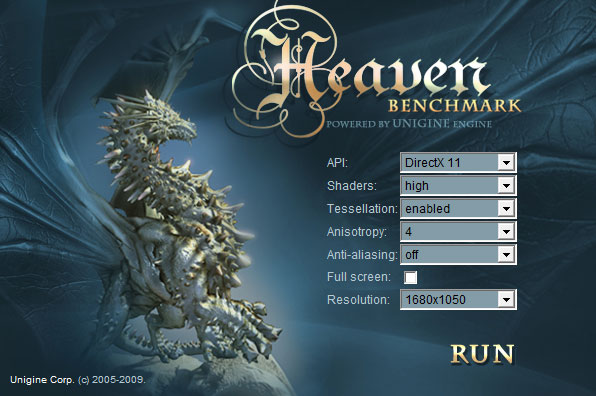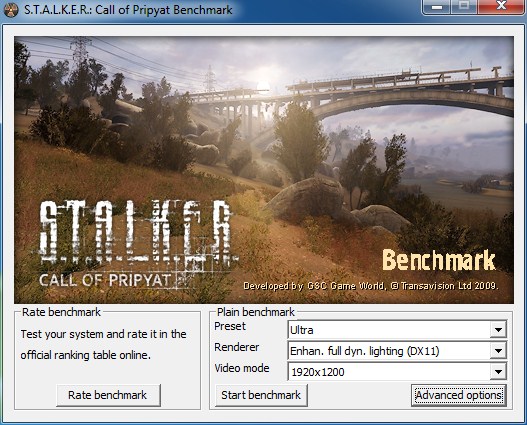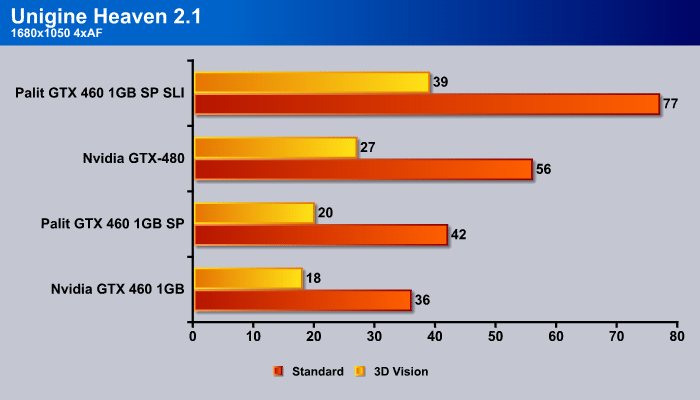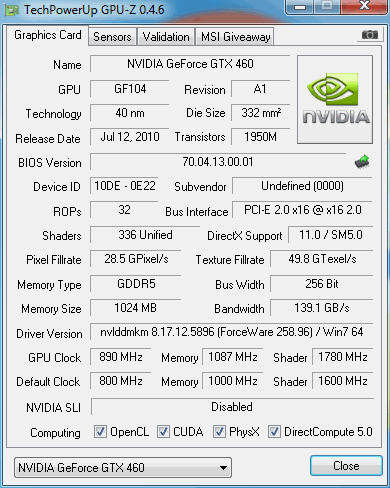The Palit GTX 460 Sonic Platinum 1GB video cards might just be the best bang for the buck video cards on the market. With two factory overclocked Palit GTX 460s you can enjoy games with pure smoothness, as well as experience smooth 3D performance.
Introduction – Palit GTX 460 Sonic Platinum 1Gb GDDR5 Video Cards in SLI
Our previous reviews showed how nicely the latest Fermi GTX 460s perform compared to the higher end GTX 470 and top of the line GTX 480. While the charted performance on the GTX 460 did lack compared to the GTX 480 (this was due to a lower amount of stream processors on the GTX 460), the real-life performance in today’s latest games was still quite pleasing. In some instances, the stock GTX 460 did have a bit higher performance over the GTX 470, and Palit has now introduced an even faster version of the mainstream GTX 460: the Palit GTX 460 Sonic Platinum 1GB GDDR5.
The Palit GTX 460 Sonic Platinum comes with 336 Stream Processors, along with a 1GB 256-bit GDDR5 memory. The stock GTX 460 also had these specifications, but the performance increase the Sonic Platinum has actually comes from the core speed and memory speed improvement. The Palit GTX 460 Sonic Platinum runs at a core speed of 800MHz, a shader clock speed of 1600MHz, and a memory frequency of 2000MHz. That’s a 125MHz increase over the standard 675MHz core speed, a 250MHz increase on the shader clock speed, and a 200MHz increase on the Memory frequency from 1800MHz. Palit also redesigned the layout of the GTX 460 (including the cooler), to make sure that the GTX 460 Sonic Platinum runs optimally.
The problem with the stock GTX 460s, is that they lack in performance on higher resolutions, especially above 1920 x 1080. While some users only own monitors that only go up to 1680 x 1050, others might want to experience full performance at these resolutions. This is where the Sonic Platinum comes in with the extra performance. To spice things up a bit more, Palit provided us with two GTX 460 Sonic Platinum video cards for some SLI action. We will see how well it performs at high resolutions like 1920 x 1200, and do price and performance comparisons between two GTX 460s and one GTX 480. We’ll also compare performance differences between two GTX 460 reference cards and the Sonic Platinum cards.
Because the GTX 480 retails at around $499, it will be interesting to see how these GTX 460 Sonic Platinum ($249 MSRP) compare against one single GTX 480. Is it possible to get more performance out of two GTX 460s than out of one GTX 480 for the same price? We’ll answer these questions in this review.
|
|
|||||||||||||||
|
||||||||||||||||
| Feature/Specification | Nvidia GTX 460 1GB GDDR5 | Palit GTX 460 Sonic Platinum 1GB GDDR5 |
|---|---|---|
| CUDA Cores |
336 |
336 |
| Graphics Clock (MHz) |
675MHz |
800MHz |
| Processor clock (MHz) |
1350MHz |
1600MHz |
| Texture Fill Rate (billion/sec) |
37.8 | 44.8 |
| Memory Clock (MHz) | 1800MHz | 2000MHz |
| Standard Memory Config |
1GB GDDR5 |
1GB GDDR5 |
| Memory Interface Width |
256-bit | 256-bit |
| Memory Bandwidth (GB/sec) |
115.2 | 128.0 |
| Height / Length / Width | 4.376in / 8.25in / Dual-slot | 4.376in / 7.5in / Dual-slot |
As previously mentioned, the Graphics Clock speed has been improved by 125MHz on the Sonic Platinum, along with a 250MHz increase on the Processor (Shader) Clock speed and and a 200Mhz increase in the Memory Clock Speed. All of these improvements help tremendously in rendering games at a higher frames-per-second rate. Since Palit completely redesigned their PCB, their GTX 460 only comes in at 7.5 inches instead of the standard 8.25 inches. This also helps a lot in HTPCs and cases that are short on space.
The Evolution of Multi-Display Gaming powered by GeForce® GTX 400 Series GPUs
Imagine expanding your gaming real estate across three displays in Full HD 3D for a completely immersive gaming experience. With the introduction of NVIDIA GeForce GTX 400 GPUs, you can now use the award winning NVIDIA 3D Vision to build the world’s first multi-display 3D gaming experience on your PC.
EXPAND YOUR GAMING REAL-ESTATE FOR THE ULTIMATE IMMERSIVE EXPERIENCE.
> Get a complete view of the battlefield in real-time strategy games.
> Manage your inventory windows, quest logs, and track your party in your favorite MMORPGs.
> See your enemy’s movement quicker and react first in first-person-shooters.
> Immerse yourself in the driver seat of your favorite racing game and be a part of the action.
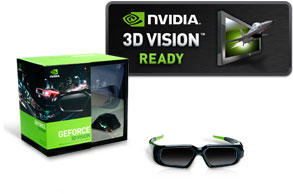 |
3D GAMING ACROSS THREE 1080P DISPLAYS, FOR A BREATHTAKING GAMING EXPERIENCE. > 3D gaming across three 1080p displays, for a breathtaking gaming experience. > Advanced NVIDIA software automatically converts over 425 games to stereoscopic 3D without the need for special game patches. > GeForce GTX 400 GPUs deliver the graphics horsepower to drive 750M pixels/second for screen 3 times Full HD 1080p 3D Vision gaming for an incredible 5760×1080 experience. > Compatible with all 3D Vision-Ready desktop monitors and projectors. |
| GET UP AND GAMING IN MINUTES WITH THE WORLD’S MOST ADVANCED MULTI-DISPLAY SOFTWARE. > Works with all standard monitor connectors, without requiring special display adapter dongles. > Simple to use setup wizard guides users through setup and allows bezel correction to enable a seamless display experience. > Advanced GPU synchronization ensures seamless support and maximum framerate > Use Accessory Displays to watch movies, browse the web, or chat with friends. |
 |
NVIDIA PureVideo Technology
NVIDIA® PureVideo® technology brings movies to life. PureVideo uses advanced techniques found only on very high-end consumer players and TVs to make Blu-ray, HD DVD, standard-definition DVD movies, PC and mobile device content look crisp, clear, smooth and vibrant. Regardless of whether you’re watching on an LCD monitor or a plasma TV, with PureVideo the picture will always be precise, vivid and lifelike.
PureVideo is included on the processing cores on NVIDIA GPUs and handheld devices for the decoding and playback of video. If your PC is equipped with one of these GPUs, you can take advantage of PureVideo and PureVideo HD. NVIDIA applications processors also leverage this technology to deliver top class video quality to mobile devices.
 |
NVIDIA PureVideo HD
Available on select NVIDIA® GeForce® 7,8, and 9 series and NVIDIA Quadro® GPUs, PureVideo HD is a superset of the PureVideo functionality that is essential for the ultimate
Blu-ray and HD DVD movie experience on a Desktop PC or notebook computer. Learn More
 |
NVIDIA PureVideo
Available on most NVIDIA GeForce, NVIDIA APX applications processors and NVIDIA Quadro GPUs, PureVideo is for playback of standard-definition DVDs, PC video and mobile content. Learn More
What is CUDA?
CUDA is NVIDIA’s parallel computing architecture that enables dramatic increases in computing performance by harnessing the power of the GPU (graphics processing unit).
With millions of CUDA-enabled GPUs sold to date, software developers, scientists and researchers are finding broad-ranging uses for CUDA, including image and video processing, computational biology and chemistry, fluid dynamics simulation, CT image reconstruction, seismic analysis, ray tracing and much more.
Computing is evolving from “central processing” on the CPU to “co-processing” on the CPU and GPU. To enable this new computing paradigm, NVIDIA invented the CUDA parallel computing architecture that is now shipping in GeForce, ION, Quadro, and Tesla GPUs, representing a significant installed base for application developers.
In the consumer market, nearly every major consumer video application has been, or will soon be, accelerated by CUDA, including products from Elemental Technologies, MotionDSP and LoiLo, Inc.
CUDA has been enthusiastically received in the area of scientific research. For example, CUDA now accelerates AMBER, a molecular dynamics simulation program used by more than 60,000 researchers in academia and pharmaceutical companies worldwide to accelerate new drug discovery.
In the financial market, Numerix and CompatibL announced CUDA support for a new counterparty risk application and achieved an 18X speedup. Numerix is used by nearly 400 financial institutions.
An indicator of CUDA adoption is the ramp of the Tesla GPU for GPU computing. There are now more than 700 GPU clusters installed around the world at Fortune 500 companies ranging from Schlumberger and Chevron in the energy sector to BNP Paribas in banking.
And with the recent launches of Microsoft Windows 7 and Apple Snow Leopard, GPU computing is going mainstream. In these new operating systems, the GPU will not only be the graphics processor, but also a general purpose parallel processor accessible to any application.
For information on CUDA and OpenCL, click here.
For information on CUDA and DirectX, click here.
For information on CUDA and Fortran, click here.
PhysX
Some Games that use PhysX (Not all inclusive)
 |
Batman: Arkham Asylum Watch Arkham Asylum come to life with NVIDIA® PhysX™ technology! You’ll experience ultra-realistic effects such as pillars, tile, and statues that dynamically destruct with visual explosiveness. Debris and paper react to the environment and the force created as characters battle each other; smoke and fog will react and flow naturally to character movement. Immerse yourself in the realism of Batman Arkham Asylum with NVIDIA PhysX technology. |
 |
Darkest of Days Darkest of Days is a historically based FPS where gamers will travel back and forth through time to experience history’s “darkest days”. The player uses period and future weapons as they fight their way through some of the epic battles in history. The time travel aspects of the game, lead the player on missions where they at times need to fight on both sides of a war. |
 |
Sacred 2 – Fallen Angel In Sacred 2 – Fallen Angel, you assume the role of a character and delve into a thrilling story full of side quests and secrets that you will have to unravel. Breathtaking combat arts and sophisticated spells are waiting to be learned. A multitude of weapons and items will be available, and you will choose which of your character’s attributes you will enhance with these items in order to create a unique and distinct hero. |
 |
Dark Void Dark Void is a sci-fi action-adventure game that combines an adrenaline-fuelled blend of aerial and ground-pounding combat. Set in a parallel universe called “The Void,” players take on the role of Will, a pilot dropped into incredible circumstances within the mysterious Void. This unlikely hero soon finds himself swept into a desperate struggle for survival. |
 |
Cryostasis Cryostasis puts you in 1968 at the Arctic Circle, Russian North Pole. The main character, Alexander Nesterov is a meteorologist incidentally caught inside an old nuclear ice-breaker North Wind, frozen in the ice desert for decades. Nesterov’s mission is to investigate the mystery of the ship’s captain death – or, as it may well be, a murder. |
 |
Mirror’s Edge In a city where information is heavily monitored, agile couriers called Runners transport sensitive data away from prying eyes. In this seemingly utopian paradise of Mirror’s Edge, a crime has been committed and now you are being hunted. |
What is NVIDIA PhysX Technology?
NVIDIA® PhysX® is a powerful physics engine enabling real-time physics in leading edge PC games. PhysX software is widely adopted by over 150 games and is used by more than 10,000 developers. PhysX is optimized for hardware acceleration by massively parallel processors. GeForce GPUs with PhysX provide an exponential increase in physics processing power taking gaming physics to the next level.
What is physics for gaming and why is it important?
Physics is the next big thing in gaming. It’s all about how objects in your game move, interact, and react to the environment around them. Without physics in many of today’s games, objects just don’t seem to act the way you’d want or expect them to in real life. Currently, most of the action is limited to pre-scripted or ‘canned’ animations triggered by in-game events like a gunshot striking a wall. Even the most powerful weapons can leave little more than a smudge on the thinnest of walls; and every opponent you take out, falls in the same pre-determined fashion. Players are left with a game that looks fine, but is missing the sense of realism necessary to make the experience truly immersive.
With NVIDIA PhysX technology, game worlds literally come to life: walls can be torn down, glass can be shattered, trees bend in the wind, and water flows with body and force. NVIDIA GeForce GPUs with PhysX deliver the computing horsepower necessary to enable true, advanced physics in the next generation of game titles making canned animation effects a thing of the past.
Which NVIDIA GeForce GPUs support PhysX?
The minimum requirement to support GPU-accelerated PhysX is a GeForce 8-series or later GPU with a minimum of 32 cores and a minimum of 256MB dedicated graphics memory. However, each PhysX application has its own GPU and memory recommendations. In general, 512MB of graphics memory is recommended unless you have a GPU that is dedicated to PhysX.
How does PhysX work with SLI and multi-GPU configurations?
When two, three, or four matched GPUs are working in SLI, PhysX runs on one GPU, while graphics rendering runs on all GPUs. The NVIDIA drivers optimize the available resources across all GPUs to balance PhysX computation and graphics rendering. Therefore users can expect much higher frame rates and a better overall experience with SLI.
A new configuration that’s now possible with PhysX is 2 non-matched (heterogeneous) GPUs. In this configuration, one GPU renders graphics (typically the more powerful GPU) while the second GPU is completely dedicated to PhysX. By offloading PhysX to a dedicated GPU, users will experience smoother gaming.
Finally we can put the above two configurations all into 1 PC! This would be SLI plus a dedicated PhysX GPU. Similarly to the 2 heterogeneous GPU case, graphics rendering takes place in the GPUs now connected in SLI while the non-matched GPU is dedicated to PhysX computation.
Why is a GPU good for physics processing?
The multithreaded PhysX engine was designed specifically for hardware acceleration in massively parallel environments. GPUs are the natural place to compute physics calculations because, like graphics, physics processing is driven by thousands of parallel computations. Today, NVIDIA’s GPUs, have as many as 480 cores, so they are well-suited to take advantage of PhysX software. NVIDIA is committed to making the gaming experience exciting, dynamic, and vivid. The combination of graphics and physics impacts the way a virtual world looks and behaves.
Direct Compute
DirectCompute Support on NVIDIA’s CUDA Architecture GPUs
Microsoft’s DirectCompute is a new GPU Computing API that runs on NVIDIA’s current CUDA architecture under both Windows VISTA and Windows 7. DirectCompute is supported on current DX10 class GPU’s and DX11 GPU’s. It allows developers to harness the massive parallel computing power of NVIDIA GPU’s to create compelling computing applications in consumer and professional markets.
As part of the DirectCompute presentation at the Game Developer Conference (GDC) in March 2009 in San Francisco CA, NVIDIA demonstrated three demonstrations running on a NVIDIA GeForce GTX 280 GPU that is currently available. (see links below)
As a processor company, NVIDIA enthusiastically supports all languages and API’s that enable developers to access the parallel processing power of the GPU. In addition to DirectCompute and NVIDIA’s CUDA C extensions, there are other programming models available including OpenCL™. A Fortran language solution is also in development and is available in early access from The Portland Group.
NVIDIA has a long history of embracing and supporting standards since a wider choice of languages improve the number and scope of applications that can exploit parallel computing on the GPU. With C and Fortran language support here today and OpenCL and DirectCompute available this year, GPU Computing is now mainstream. NVIDIA is the only processor company to offer this breadth of development environments for the GPU.
OpenCL
| OpenCL (Open Computing Language) is a new cross-vendor standard for heterogeneous computing that runs on the CUDA architecture. Using OpenCL, developers will be able to harness the massive parallel computing power of NVIDIA GPU’s to create compelling computing applications. As the OpenCL standard matures and is supported on processors from other vendors, NVIDIA will continue to provide the drivers, tools and training resources developers need to create GPU accelerated applications.
In partnership with NVIDIA, OpenCL was submitted to the Khronos Group by Apple in the summer of 2008 with the goal of forging a cross platform environment for general purpose computing on GPUs. NVIDIA has chaired the industry working group that defines the OpenCL standard since its inception and shipped the world’s first conformant GPU implementation for both Windows and Linux in June 2009. |
 |
NVIDIA has been delivering OpenCL support in end-user production drivers since October 2009, supporting OpenCL on all 180,000,000+ CUDA architecture GPUs shipped since 2006.
NVIDIA’s Industry-leading support for OpenCL:
2010
March – NVIDIA releases updated R195 drivers with the Khronos-approved ICD, enabling applications to use OpenCL NVIDIA GPUs and other processors at the same time
January – NVIDIA releases updated R195 drivers, supporting developer-requested OpenCL extensions for Direct3D9/10/11 buffer sharing and loop unrolling
January – Khronos Group ratifies the ICD specification contributed by NVIDIA, enabling applications to use multiple OpenCL implementations concurrently
2009
November – NVIDIA releases R195 drivers with support for optional features in the OpenCL v1.0 specification such as double precision math operations and OpenGL buffer sharing
October – NVIDIA hosts the GPU Technology Conference, providing OpenCL training for an additional 500+ developers
September – NVIDIA completes OpenCL training for over 1000 developers via free webinars
September – NVIDIA begins shipping OpenCL 1.0 conformant support in all end user (public) driver packages for Windows and Linux
September – NVIDIA releases the OpenCL Visual Profiler, the industry’s first hardware performance profiling tool for OpenCL applications
July – NVIDIA hosts first “Introduction to GPU Computing and OpenCL” and “Best Practices for OpenCL Programming, Advanced” webinars for developers
July – NVIDIA releases the NVIDIA OpenCL Best Practices Guide, packed with optimization techniques and guidelines for achieving fast, accurate results with OpenCL
July – NVIDIA contributes source code and specification for an Installable Client Driver (ICD) to the Khronos OpenCL Working Group, with the goal of enabling applications to use multiple OpenCL implementations concurrently on GPUs, CPUs and other types of processors
June – NVIDIA release first industry first OpenCL 1.0 conformant drivers and developer SDK
April – NVIDIA releases industry first OpenCL 1.0 GPU drivers for Windows and Linux, accompanied by the 100+ page NVIDIA OpenCL Programming Guide, an OpenCL JumpStart Guide showing developers how to port existing code from CUDA C to OpenCL, and OpenCL developer forums
2008
December – NVIDIA shows off the world’s first OpenCL GPU demonstration, running on an NVIDIA laptop GPU at
June – Apple submits OpenCL proposal to Khronos Group; NVIDIA volunteers to chair the OpenCL Working Group is formed
2007
December – NVIDIA Tesla product wins PC Magazine Technical Excellence Award
June – NVIDIA launches first Tesla C870, the first GPU designed for High Performance Computing
May – NVIDIA releases first CUDA architecture GPUs capable of running OpenCL in laptops & workstations
2006
November – NVIDIA released first CUDA architecture GPU capable of running OpenCL
A Closer Look
When we take off the top cover of the GTX 460 Sonic Platinum, the new cooler design is revealed. There is a massive surface area that the GPU can contact with, and the two massive heatpipes transfer the heat to the aluminum fins. According to our close-up pictures, it looks like the heatsink fins are soldered to the heatpipes, providing extra cooling performance.
Finally, in these last two pictures, we see another angle of the new heatsink design, and the cover that comes with the GTX 460. The construction of the cover is plastic, along with a really light fan. According to our tests, the fan does provide an efficient amount of air at 100%, but we were expecting a bit more performance out of the fan at 100%. It also looks like Palit is using a newer BIOS on these cards that lowers the RPM on the fans, because it has been noted that the engineering samples ran noisier.
Testing Methodology
To test the Palit GTX 460’s, we did a fresh load of Windows 7 Ultimate, then applied all the updates we could find. We installed the latest motherboard drivers for the Gigabyte GA-X58A-UD7, updated the BIOS to the latest FB BIOS, and loaded our test suite. Then we installed the latest nVidia drivers from nVidia’s website.
We ran each test a total of 3 times, and reported the average score from all three scores. Benchmark screenshots are of the median result. Anomalous results were discounted and the benchmarks were rerun.
Please note that due to new driver releases with performance improvements, we rebenched every card shown in the results section. The results here will be different than previous reviews due to the performance increases in drivers.
Test Rig
| Test Rig | |
| Case | Silverstone Temjin TJ10 |
| CPU |
Intel Core i7 930 @ 3.8GHz |
| Motherboard |
GIGABYTE X58A-UD7 Motherboard – LGA1366 |
| Ram | OCZ 12GB DDR3-12800 1600Mhz (8-8-8-24 1.65v) Kit |
| CPU Cooler | Thermalright True Black 120 with 2x Noctua NF-P12 Fans |
| Hard Drives |
4x Seagate Cheetah 600GB 10K 6Gb/s Hard Drives 2x Western Digital RE3 1TB 7200RPM 3Gb/s Hard Drives |
| Optical | ASUS DVD-Burner |
| GPU |
2x Palit GTX460 Sonic Platinum 1GB GDDR5 Video Cards in SLI |
| Case Fans |
2x Noctua NF-P12 120mm Fans – Top 1x Silverstone 120mm Fan – Front and Back 1x Noctua NF-P12 120mm Fans – Hard Drive Compartment 1x Noctua NF-B9 92mm Fan Mounted right next to Video Cards for side ventilation. (Case does not come with side ventilation) |
| Additional Cards |
LSI 3ware SATA + SAS 9750-8i 6Gb/s RAID Card |
| PSU |
Sapphire PURE 1250W Modular Power Supply |
| Mouse | Logitech G5 |
| Keyboard | Logitech G15 |
Synthetic Benchmarks & Games
We will use the following applications to benchmark the performance of the Palit GTX 460 Sonic Platinum 1GB GDDR5 video cards. We are also going to use Unigine Heaven to try the 3D performance of the cards.
| Synthetic Benchmarks & Games | |
| 3DMark Vantage | |
| Metro 2033 | |
| Stone Giant | |
| Unigine Heaven v.2.1 | |
| Crysis | |
| Crysis Warhead | |
| Stalker COP | |
Crysis v. 1.21
Crysis is the most highly anticipated game to hit the market in the last several years. Crysis is based on the CryENGINE™ 2 developed by Crytek. The CryENGINE™ 2 offers real time editing, bump mapping, dynamic lights, network system, integrated physics system, shaders, shadows, and a dynamic music system, just to name a few of the state-of-the-art features that are incorporated into Crysis. As one might expect with this number of features, the game is extremely demanding of system resources, especially the GPU. We expect Crysis to be a primary gaming benchmark for many years to come.
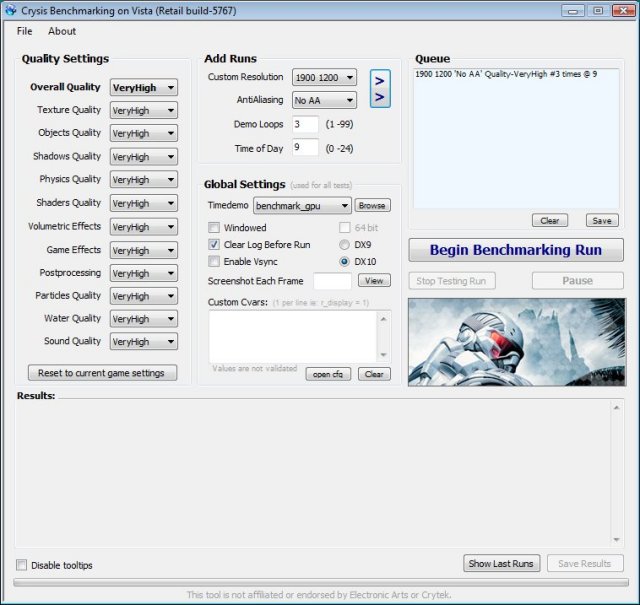
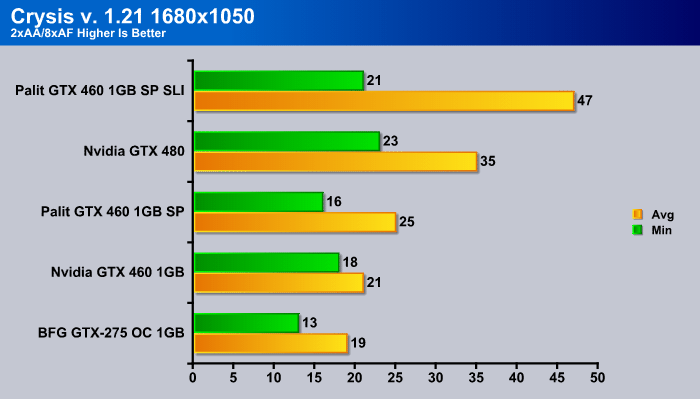
The main purpose of our testing is to see how far two GTX 460 Sonic Platinums will go compared to a GTX 480. We have also included the single GTX 460 Sonic Platnium to compare it to a reference GTX 460 card and the GTX 480. From the first Crysis benchmark we can see that while one Palit GTX 460 Sonic Platinum video card does not catch up with the GTX 480, the SLI setup of the Palit cards blows the GTX 480 out of the water with a 12FPS increase.
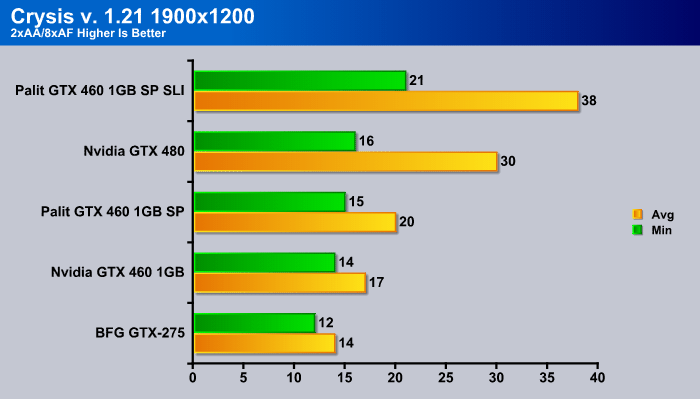
We get very similar results on the higher resolution benchmarks as well. But in this case the GTX 480 Sonic Platinum does not get the full 12FPS increase between the GTX 480 and the GTX 460. There is a whooping 8FPS difference that puts the GTX 480 to shame. The performance increase from the reference Nvidia GTX 460 is 3FPS, which shows that the Sonic Platinum does really run at higher clock speeds.
CRYSIS WARHEAD
Crysis Warhead is the much anticipated standalone expansion to Crysis, featuring an updated CryENGINE™ 2 with better optimization. It was one of the most anticipated titles of 2008.

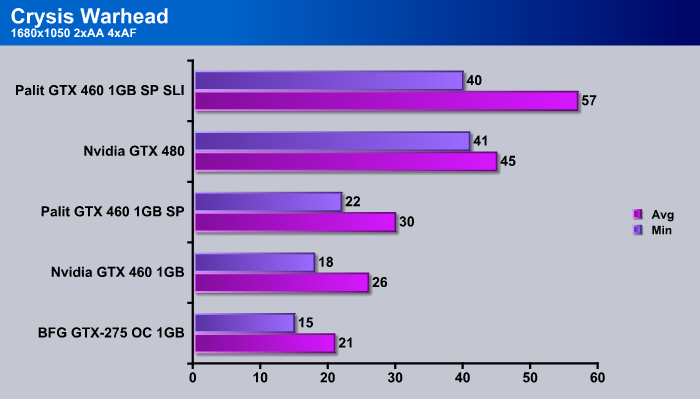
Crysis Warhead is extremely similar to Crysis, but we ran it as well to compare the performance of each card. Once again, the Palit GTX 460 Sonic Platinum puts the GTX 480 to shame, but interestingly the GTX 480 has a higher minimum FPS then the two Palit GTX 460 Sonic Platinum video cards.
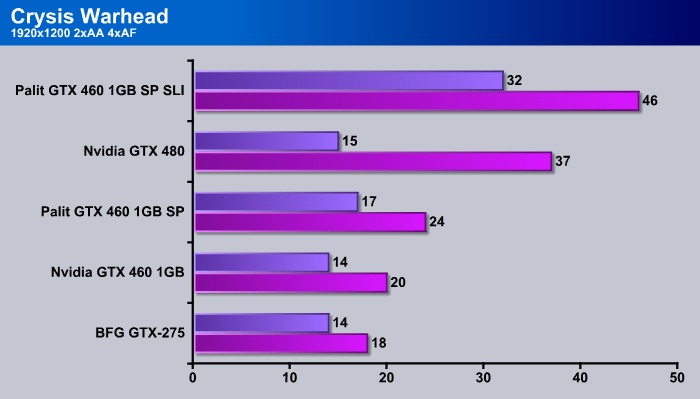
In the 1920×1200 resolution test, the GTX 480 fell drastically in minimum frames per second compared to the other cards. We are not entirely sure why this happened, but the pattern persisted through several test runs. The Palit GTX 460 Sonic Platinum video cards in SLI had a very nice 32FPS as a minimum score, which means that the game should be lag free. The average 46FPS puts the game at a place where gaming is very enjoyable and without any lags.
Unigine Heaven 2.1
Unigine Heaven is a benchmark program based on Unigine Corp’s latest engine, Unigine. The engine features DirectX 11, Hardware tessellation, DirectCompute, and Shader Model 5.0. All of these new technologies combined with the ability to run each card through the same exact test means this benchmark should be in our arsenal for a long time.

At 1680 x 1050 resolution, the GTX 460 in SLI had a very nice 11FPS increase over the GTX 480. According to the stock GTX 460s in SLI, the performance to the GTX 480 should be very similar, but a bit faster. With the Palit GTX 460 Sonic Platinum video cards, the performance increase is a lot faster. This is because two factory overclocked cards are combined for extra performance increase.

At higher resolutions, the more work we put the GTX 460 Sonic Platinum cards to, the higher they scored from the GTX 480. At the Extreme Tessellation setting, the GTX 460 Sonic Platinum was able to produce 15FPS higher then the stock GTX 480. The performance between a stock GTX 460 and the Sonic Platinum was also very good, with the Sonic Platinum performing up to 5FPS higher then the stock card.
Stone Giant
We used a 90 second Fraps run and recorded the Min/Avg/Max FPS rather than rely on the built in utility for determining FPS. We started the benchmark, triggered Fraps and let it run on stock settings for 90 seconds without making any adjustments of changing camera angles. We just let it run at default and had Fraps record the FPS and log them to a file for us.
Key features of the BitSquid Tech (PC version) include:
- Highly parallel, data oriented design
- Support for all new DX11 GPUs, including the NVIDIA GeForce GTX 400 Series and AMD Radeon 5000 series
- Compute Shader 5 based depth of field effects
- Dynamic level of detail through displacement map tessellation
- Stereoscopic 3D support for NVIDIA 3dVision
“With advanced tessellation scenes, and high levels of geometry, Stone Giant will allow consumers to test the DX11-credentials of their new graphics cards,” said Tobias Persson, Founder and Senior Graphics Architect at BitSquid. “We believe that the great image fidelity seen in Stone Giant, made possible by the advanced features of DirectX 11, is something that we will come to expect in future games.”
“At Fatshark, we have been creating the art content seen in Stone Giant,” said Martin Wahlund, CEO of Fatshark. “It has been amazing to work with a bleeding edge engine, without the usual geometric limitations seen in current games”.
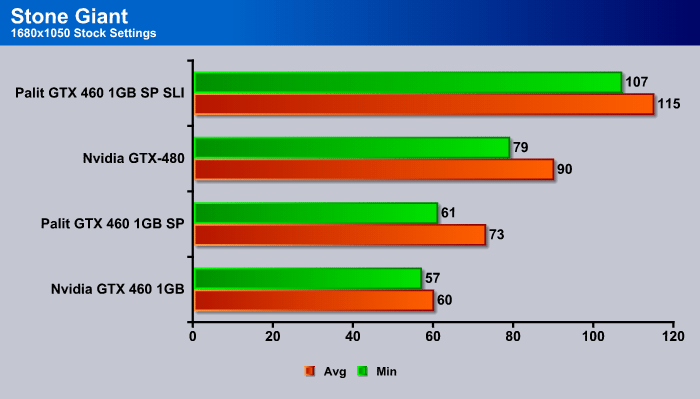
Stone Giant ran similarly to the previous benchmarks that we did.
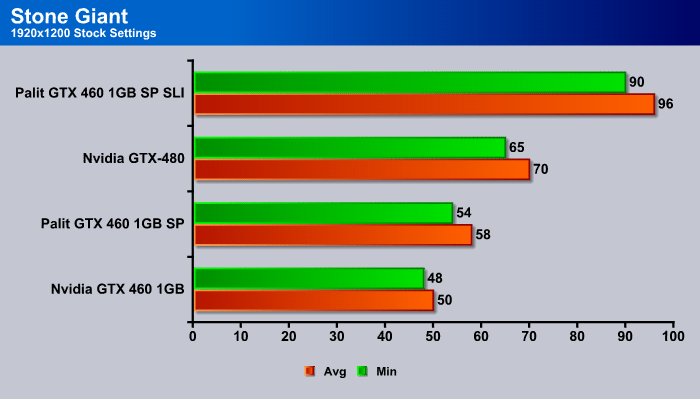
For some reason, Stone Giant ran quite a bit slower on the GTX 480 at the higher resolution then on the SLI setup. It appears that the reason behind this is that a SLI setup can handle the tesselation better then a single GPU setup.
Metro 2033
Metro 2033 is an action-oriented video game blending survival horror and first-person shooter elements. The game is based on the novel Metro 2033 by Russian author Dmitry Glukhovsky. It was developed by 4A Games in Ukraine and released in March 2010 for the Xbox 360 and Microsoft Windows. In March 2009, 4A Games announced a partnership with Glukhovsky to collaborate on the game. The game was announced a few months later at the 2009 Games Convention in Leipzig; a first trailer came along with the announcement. When the game was announced, it had the subtitle “The Last Refuge,” but this subtitle is no longer being used.
The game is played from the perspective of a character named Artyom. The story takes place in post-apocalyptic Moscow, mostly inside the metro system where the player’s character was raised (he was born before the war, in an unharmed city). The player must occasionally go above ground on certain missions and scavenge for valuables.
The game’s locations reflect the dark atmosphere of real metro tunnels, albeit in a more sinister and bizarre fashion. Strange phenomena and noises are frequent, and mostly the player has to rely on their flashlight and quick thinking to find their way around in total darkness. Even more lethal is the surface, as it is severely irradiated and a gas mask must be worn at all times due to the toxic air. Water can often be contaminated as well, and short contacts can cause heavy damage to the player, or even kill outright.
Often, locations have an intricate layout, and the game lacks any form of map, leaving the player to try and find its objectives only through a compass – weapons cannot be used while visualizing it, leaving the player vulnerable to attack during navigation. The game also lacks a health meter, relying on audible heart rate and blood spatters on the screen to show the player how close he or she is to death. There is no on-screen indicator to tell how long the player has until the gas mask’s filters begin to fail, save for a wristwatch that is divided into three zones, signaling how much the filter can endure, so players must continue to check it every time they wish to know how long they have until their oxygen runs out. Players must replace the filters, which are found throughout the game. The gas mask also indicates damage in the form of visible cracks, warning the player a new mask is needed. The game does feature traditional HUD elements, however, such as an ammunition indicator and a list of how many gas mask filters and adrenaline (health) shots remain.
Another important factor is ammunition management. As money lost its value in the game’s setting, cartridges are used as currency. There are two kinds of bullets that can be found: those of poor quality made by the metro-dwellers, and those made before the nuclear war. The ones made by the metro-dwellers are more common, but less effective against the dark denizens of the underground labyrinth. The pre-war ones, which are rare and highly powerful, are also necessary to purchase gear or items such as filters for the gas mask and med kits. Thus, the game involves careful resource management.
We left Metro 2033 on all high settings with Depth of Field on.
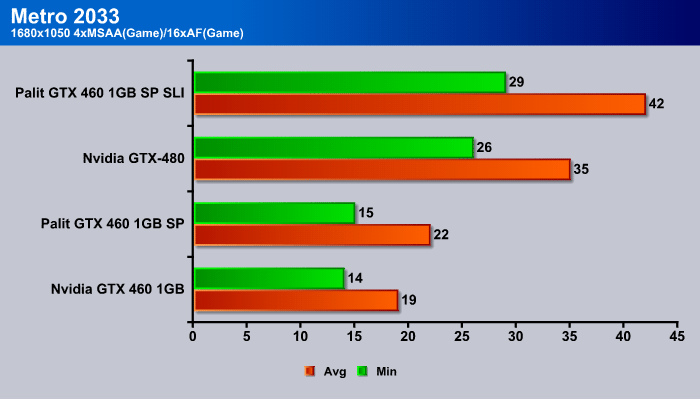
We ran Metro on DX11 and on max settings and everything was enabled, including PhysX. Metro 2033 really put the single GTX 460 to shame at 1680×1050, and the game was unplayable during action. With SLI, the game became playable again and was quite smooth. During action scenes the game still lagged somewhat, but was playable. With a single GTX 480, the game was still playable, but the SLI setup performed better.

The higher resolution made the game unplayable during action scenes in every configuration except SLI. We would still recommend turning the AA down to minimum and running the game with PhysX disabled. We played the game at those settings, and it ran just fine then, even on 1920×1200.
3DMark Vantage
For complete information on 3DMark Vantage Please follow this Link:
www.futuremark.com/benchmarks/3dmarkvantage/features/
The newest video benchmark from the gang at Futuremark. This utility is still a synthetic benchmark, but one that more closely reflects real world gaming performance. While it is not a perfect replacement for actual game benchmarks, it has its uses. We tested our cards at the ‘Performance’ setting.
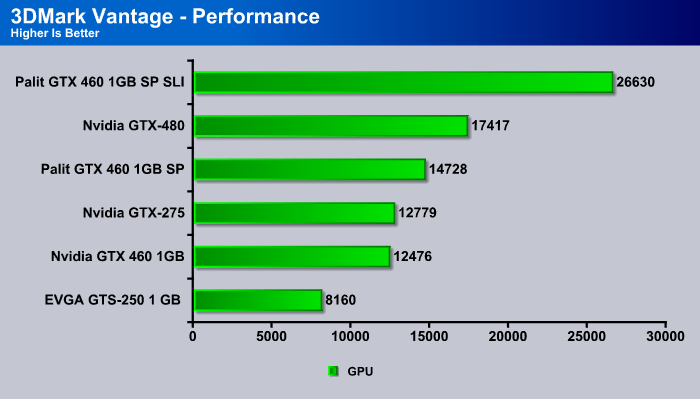
3DMark Vantage still uses DirectX10, so we ran several other cards for comparison. We ran a GTS 250 mainstream video card, along with a GTX 275 high-end card to compare againsg the GTX 460. While the reference Nvidia GTX 460 ran a slightly slower than the GTX 275, the Palit GTX 460 Sonic Platinum ran quite a bit faster then the GTX 275. Once we enabled SLI, the Palit GTX 460 Sonic Platinum scored roughly a whopping 10,000 points higher than a single GTX 480.
S.T.A.L.K.E.R.: Call of Pripyat
Call of Pripyat is the latest addition to the S.T.A.L.K.E.R. franchise. S.T.A.L.K.E.R. has long been considered “the thinking man’s shooter,” because it gives the player many different ways of completing the objectives. The game includes new advanced DirectX 11 effects as well as the continuation of the story from the previous games.
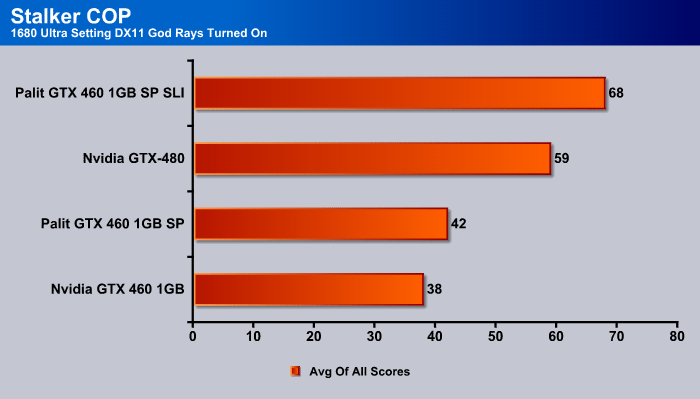
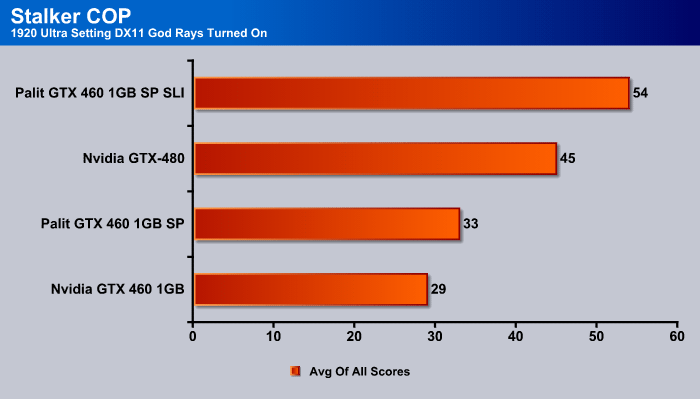
The results on S.T.A.L.K.E.R.: Call of Pripyat are very similar to the other scores we have already seen. There is not much explanation necessary here.
3D performance compred to standard
Since 3D is changing the gaming industry, we found it interesting to see how the performance will keep up on a SLI setup compared to a single video card setup while playing games on 3D. From the Unigine Heaven 2.1 benchmark, we can clearly see that the performance of a 3D setup is about 50% of the non-3D setup. This does make sense, because the image on the screen needs to be rendered twice, instead of just once.
To summarize the results, it is highly recommended to choose a SLI setup, even if it is just a GTX 460, because the difference between a single setup and a SLI setup will the the difference between laggish gameplay or smooth gameplay. The GTX 480 will not be able to keep up with some of the newest games in 3D if it is not used in SLI, but the GTX 460 in SLI will most likely be able to play the games on max settings in 3D. Depending on the game, if it is very intensive graphically, players still might have to lower the eye candy in the games if playing in 3D.
Overclocking
The maximum stable overclock that we could get on the GTX 460s in SLI was 890Mhz GPU clock speed, 2174MHz for the Memory and 1780MHz clock speed for the Shader. We had to raise the voltage to 1050mv from the standard 1000mv.
Game performance ranged between 2-4fps increase. This increase helps nicely when there is a game that has a lag or two every now and then. It helps smooth out those areas, however, if the game is already lagging, it will not do much.
TEMPERATURES
The first column of temperatures shows the current temperatures, which do not really reflect the temperatures we want to see. The second column shows the minimum temperatures that were recorded during idle operation. The third column of temperatures shows the maximum temperatures that were recorded after 1 hour of operation. For FurMark, we ran the burn-in test for 20 minutes.
It is worth noting that FurMark temperatures are not realistic because a video game would not load up the video card as much as FurMark does, so take FurMark temperatures with a grain of a salt (the Mafia 2 temperatures are real-life game temperatures).
Mafia 2 SLI
Furmark SLI
Furmark Single
The first GPU in the list is GPU2, and the second GPU in the list is GPU1. The reason we see higher temperatures on GPU1 is because it takes the most load, and also intakes most of the exhaust from GPU2.
POWER CONSUMPTION
To get our power consumption numbers we plugged in our Kill A Watt power measurement device and took the Idle reading at the desktop during our temperature readings. We left it at the desktop for about 15 minutes and took the idle reading. Then we ran Mafia 2 for 10 minutes and recorded the highest power usage.
| Temperatures | Idle | Load |
|---|---|---|
| 2x Palit GTX 460 Sonic Platinum 1GB GDDR5 in SLI |
315W |
525W |
| Palit GTX 460 Sonic Platinum 1GB GDDR5 |
249W |
408W |
| Nvidia GTX 460 1GB |
237W |
395W |
| Nvidia GTX 480 |
265W |
460W |
Conclusion
The Palit GTX 460 Sonic Platinum Overclocking Edition 1GB GDDR5 video card has to be the most cost efficient video card on the market at the moment. The factory overclock that comes with the GTX 460 Sonic Platinum not only provides phenomenal performance increases in single card configuration, but even more performance increase in SLI setup. The Palit GTX 460 Sonic Platinum in SLI has enough power to blow a single GTX 480 out of the water in just about any game. The 3D performance of the video cards in SLI also proved to be great, even though some of the latest games might not play completely smooth on maximum graphics settings. Since most 3D monitors only come in smaller sizes, around 24″, a lower 1680×1050 resolution for 3D gaming would still great. On larger monitors like 28″, the resolution might have to be bumped up a step higher, but the Palit GTX 460 Sonic Platinum video cards should still have enough power up its sleeves to push out the right FPS for smooth gameplay.
We were extremely pleased with everything that Palit had to offer on the GTX 460 Sonic Platinum 1GB GDDR5 video card, along with the shorter length and the complete redesign of the PCB and the cooler on the card. The only downfall that we could see on the card was the missing VRM heatsink. Not all retail cards will come with the VRM heatsinks, resulting in higher temperatures on the board and on the GPU. The temperatures are not dangerous during game play, however.
Finally, the noise level on the card was very low. For users with no case ventilation (even though it is highly recommended to have side ventilation while running SLI), the higher RPM on the fan should not bother even during game play. We had two Palit GTX 460s running in my system, and we ran it without significant noise pollution.
| OUR VERDICT: Palit GTX460 Sonic Platinum 1GB GDDR5 Video Cards in SLI | ||||||||||||||||||
|
||||||||||||||||||
| Summary: The GTX460 Sonic Platinum 1GB GDDR5 Video Cards in SLI outperform the best of the 4 series, trouncing even the GTX 480. They provide great performance, are less expensive than the GTX 480, and are quiet. We are proud to give the GTX460 Sonic Platinum 1GB GDDR5 Video Cards our Best Bang for the Buck and Bjorn 3D Golden Bear Award. |
 Bjorn3D.com Bjorn3d.com – Satisfying Your Daily Tech Cravings Since 1996
Bjorn3D.com Bjorn3d.com – Satisfying Your Daily Tech Cravings Since 1996
